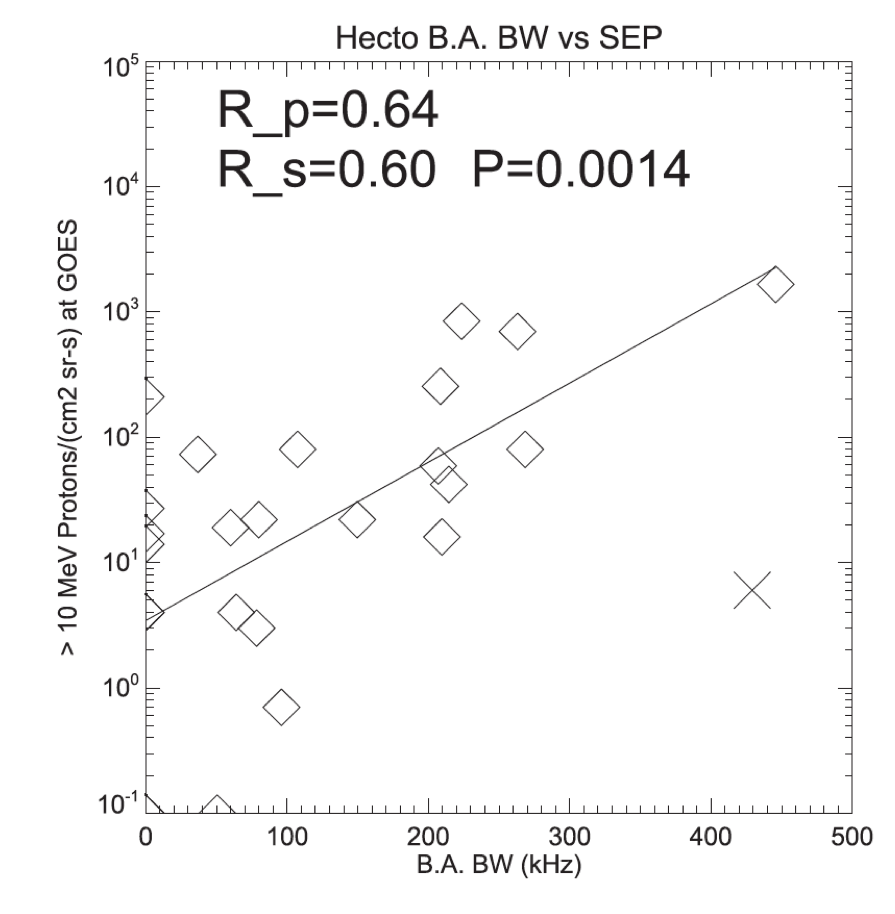Solar eruptive phenomena, such as flares and coronal mass ejections (CMEs), generate high-energy particles called solar energetic particles (SEPs). Severe SEP events sometimes cause satellite anomalies and radiation exposure to humans in space. Hence, understanding and forecasting SEPs is an important issue in space weather. Type II solar radio bursts are nonthermal radio emissions with negative frequency drift observed between the metric and kilometric frequency range. They are thought to be plasma emissions generated by nonthermal electrons accelerated by shocks propagating in the corona and/or interplanetary space. Although the type II bursts are generated from nonthermal electrons, while the SEPs are accelerated ions, many studies have suggested a close relation between the two phenomena (Gopalswamy et al. 2008, and references therein). We investigated the relationship between the spectral structures of type II solar radio bursts in the hectometric and kilometric wavelength ranges and the peak flux of SEPs.
Methods
To examine the statistical relationship between type II bursts and SEPs, we selected 26 CME events with similar characteristics (e.g., initial speed, angular width, and location) observed by the Large Angle and Spectrometric Coronagraph (LASCO), regardless of the characteristics of the corresponding type II bursts and the SEP flux. The selection criteria are as follows: a velocity between 1200 and 1800 km/s and an angular width >120°. We also limit the range of longitude for the CME source region to be between 0° and 120°, because we expect a higher likelihood of observing SEPs if the CME is from the western hemisphere due to the magnetic field connection governed by the Parker spiral. Then, we compared associated type II bursts observed by the Radio and Plasma Wave Experiment (WAVES) onboard the Wind spacecraft (Figure 1), and the SEP flux observed by the Geostationary Operational Environmental Satellite (GOES) orbiting around the Earth.

Figure 1 – Example of radio dynamic spectra of type II bursts observed on 2006 December 13.
Results and Discussions
Figure 2 shows the relationship between the SEP fluxes and bandwidth of hectometric type II bursts. We found that the bandwidth of the hectometric type II bursts and the peak flux of the SEPs has a positive correlation (Pearson’s correlation coefficient (CC), Rp, is 0.64 and the Spearman’s rank CC, Rs, is 0.67. The probability (P-value) of the observed (or more extreme) Spearman’s rank CC occurring by chance is 0.0014). This result supports the idea that the nonthermal electrons of type II bursts and the nonthermal ions of SEPs are generated by the same shock. This result also suggests that more SEPs may be generated for a wider CME shock because the bandwidth of the radio burst is related to the density gap of the emission region which can be related to the spatial scale of the emission region. This result may suggest that a shock with a larger Alfvén Mach number can produce more SEP particles considering the model proposed by Vršnak et al (2001). Our result also suggests that considering the spectral structures of type II bursts can improve the forecasting accuracy for the peak flux of gradual SEPs.

Figure 2 – Scatter plots of the peak flux of SEPs and the bandwidth of hectometric type II bursts. The linear least-squares fit lines and the CCs are shown in the plot. The ‘x’ symbol indicates the CME–CME interaction event that was excluded from the statistical analysis.
Additional info
Based on the recent paper by Iwai et al., “Spectral Structures of Type II Solar Radio Bursts and Solar Energetic Particles” The Astrophysical Journal, Volume 888, Issue 1, article id. 50, 11 pp. (2020). DOI: 10.3847/1538-4357/ab57ff
References
Gopalswamy, N., Yashiro, S., Akiyama, S., et al.: 2008, Ann. Geophys., 26, 3033
Vršnak, B., Aurass, H., Magdalenić, J., & Gopalswamy, N. 2001, A&A, 377, 321
